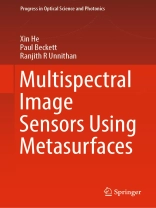This book presents how metasurfaces are exploited to develop new low-cost single sensor based multispectral cameras. Multispectral cameras extend the concept of conventional colour cameras to capture images with multiple color bands and with narrow spectral passbands. Images from a multispectral camera can extract significant amount of additional information that the human eye or a normal camera fails to capture and thus have important applications in precision agriculture, forestry, medicine, object identifications, and classifications. Conventional multispectral cameras are made up of multiple image sensors each externally fitted with a narrow passband wavelength filters, optics and multiple electronics. The need for multiple sensors for each band results in a number of problems such as being bulky, power hungry and suffering from image co-registration problems which in turn limits their wide usage. The above problems can be eliminated if a multispectral camera is developed using one single image sensor.
สารบัญ
Introduction to Metasurfaces for Optical Applications.- Metasurfaces and Multispectral Imaging.- Transmission Enhancement in Coaxial Hole Array Based Plasmonic Color Filters.- CMY Camera using Nanorod Filter Mosaic Integrated on a CMOS Image Sensor.- A Single Sensor Based Multispectral Imaging Camera.- Hybrid Color Filters for Multispectral Imaging.- Conclusions and Future Outlook.
เกี่ยวกับผู้แต่ง
Xin He received his M.Eng. and Ph.D degrees from the University of Melbourne, Australia, in 2016 and 2020 respectively. His research interests include metasurface, nano-optics and spectral imaging. He obtained advanced skills on Micro/Nano Fabrication and COMSOL Multiphysics with RF and optics model. Except publications, he also created a prototype of a multispectral image sensor with 6 bands in the visible and infrared bands for commercial exploitation.
Paul Beckett received his B. Eng. degree in Communication Engineering, M. Eng. and Ph.D. degrees from RMIT University, Melbourne, Australia, in 1975, 1984, and 2007, respectively. Recently retired after an academic career spanning 38 years, he is currently an Honorary Associate Professor with the School of Engineering, RMIT University where his research interests include the design and simulation of nanoscale architectures and the mixed–signal modeling of asynchronous reconfigurable circuits.
Ranjith R Unnithan is a Research Group Leader and Senior Lecturer at the Department of Electrical and Electronic Engineering, the University of Melbourne, Melbourne, VIC, Australia. He is also Director of sensor research at Hort-Eye Pty Ltd., Melbourne. He received his Ph.D. degree in electrical engineering from the University of Cambridge, Cambridge, U.K., in November 2011. His research areas span CMOS image sensors, AR displays, sensor electronics for biomedical applications, drone-based sensors and applications, multispectral thermal cameras, and nanophotonic engineering.












